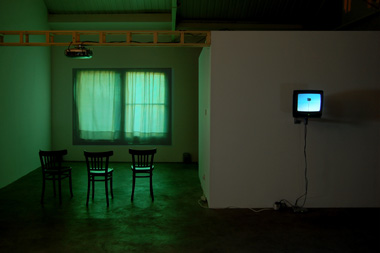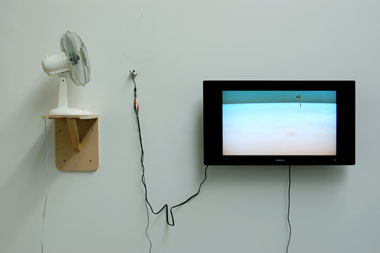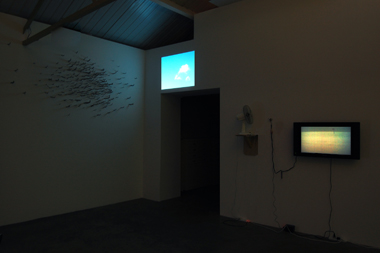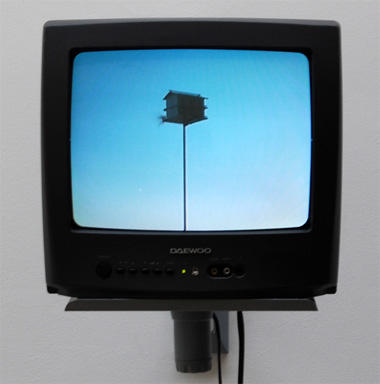 |
| Michael Snow, left : Solar breath (northern Caryatids), 60 minutes, edition no # 4/4; right : Cliona Harmey: Seneca, 2007, 4 minutes 51 seconds, Edition # 1/ 5; courtesy Mother’s Tankstation |
It occurred to me when leaving Mother’s Tankstation gallery the other day that the title of the exhibition The Last blue sky could have been a bit of a taunt to world leaders and the televised and printed media that I associate with ‘environmental exposés’. As we all know carbon emissions have become a really ‘ hot ‘ topic and Sky News has gone to town on it, with such useful information as how celebrities offset their environmental footprints and just how quickly those icecaps are melting. The Last blue sky could also be a wistful or regretful sigh, or a reminder that somewhere, over the rainbow, skies are blue. Well, at least that’s what you tell yourself during the winter months in Ireland. Especially when rounding the corner that brings you face to face with a careering wind: it rushes down streets and crashes into its squalling compatriots.
But having been blown in the door of Mother’s Tankstation, I am immediately in the projected-video presence of a young Turkish singer in inky-greenish night-vision, singing a song about life on the streets of Berlin. Each performance is followed by a daylight shot of an instrument ‘played’ by an element (alternately the wind and the rain). A harmonica is held out the window of a moving car and plays a single clear note; heavy rain-drops drum a drumkit and tinkle on its cymbals creating a pitter-patter rhythm. This video work, Nevin Aladag’s Voice over, ever so slightly mingles sonically with Elodi Pong’s untitled/ plan for victory . Pong’s work, shown on a monitor, depicts an avalanche tumbling over the pink-spray-painted words, "Plan for victory," reverberating, hollow words that could refer to our futile efforts to curb environmental destruction. The avalanche was probably executed in miniature, giving one the sense of a ‘storm in a teacup’ and, perhaps, our small stature in the face of entropy. The speakers from which the sound emanates are definitely not small and an impression of loudness is garnered, although the piece has never interfered with the other sounds in the room. It is pointed out to me by the curator of the show, Finola Jones, that it is the size of the speakers rather than the sound level that suggests loudness. Moving on and it’s oh so quite.
 |
| Ian Burns: Colony cam, 2005, mixed media, live video kinetic sculpture, dimensions variable, edition 4/5; courtesy Mother’s Tankstation |
Cliona Harmey’s Seneca gives one the impression of looking up: as though you have had to crane your neck to view it although it is presented on a monitor at (my) eye level. Birds flit in and out of a birdhouse; it is evening time; a sense of eventide calm prevails. We are over the rainbow; we are in the eye of the storm. We are meditating on the sound of birds and water. In this exhibition we have already had the sound of boys singing interspersed with the roar of an avalanche. Those sounds go on in the background, but in the world of Seneca all is quiet once more. In order to view Grace Weir’s Forgetting (the vanishing point) you actually do have to look up as it is projected at a giraffe’s eye-level. Clouds float by and vanish; we meditate once more. The combination of the title of the piece and the slow, though persistent, movement of the clouds reminds me that it is so hard to forget: it takes time. These clouds suggest the motion of time and the comfort of knowing that painful experiences might eventually be forgotten.
Wind is once more the active agent in Solar breath (northern Caryatids), a video work by Michael Snow. A slow and not quite regular rhythm is beaten out by a billowing kitchen curtain. Domestic sounds can be faintly heard. As the original Caryatids were pillars in the shape of draped female figures, there is a sense of play in the elements and forms involved. Snow’s Caryatids are formed from air and drape. They are pillars of air that seem to have no less substance in their slapping noises than those formed form marble.
 |
| The Last blue sky, installation shot, [reading from left to right], Hendrikje Kühne & Beat Klein: Schwärmerei, 2006, paper on cardboard (700 pieces), dimensions variable, Grace Weir: Forgetting (the vanishing point), 2000, 9 min 40 seconds, edition 2/3, Ian Burns: Colony cam, 2005, mixed media, live video kinetic sculpture, dimensions variable, edition 4/5; courtesy Mother’s Tankstation |
It’s definitely blowing a gale in Ian burns’ Colony cam . The wind from a standard electric fan extends a toothpick flag on a desolate landscape. A small webcam has witnessed this happening and transmitted it to a small screen. There is no perceptible delay between the view and its real-time reflection. It reminds me of Google Earth and other technologies that have ensured that even our terrestrial ‘lunar landscapes’ are available to us. Like the last of the blue skies: the last of the empty spaces – a theme that carries on to Hendrikje Kühne and Beat Klein’s Schwärmerei. Seven hundred airplanes swarm in the skies with enthusiasm made manifest. Reminding me that it’s kind of difficult to resist the cheap airline tickets nowadays, although they are accelerating the damage that we do to the environment. Our enthusiasm for travel can be offset, I suppose, following our celebrities’ example.
 |
| Cliona Harmey: Seneca, 2007, 4 minutes 51 seconds, Edition # 1/ 5; courtesy Mother’s Tankstation |
The final work in the exhibition was Thornsten Brinkmann’s Gut Ding will es so. The artist manipulates found objects such as plastic bottles and Venetian blinds. A board on wheels allows the artist to ‘swim’ along the floor doing the breaststroke. He injects the ordinary objects with new significance; their properties are tested, reminding me of the musical instruments played by the wind and the rain in Nevin Aladag’s video. Brinkmann’s movements have been sped up, adding a sense of urgency and associating the activities with the slightly speedy and jumpy movements of early silent cinema. As a fullstop to this show we are amused and intrigued in turn: testing these objects with his body hightlights the fact that the body has been all but absent in all of the previous work, apart from Aladags’, and even then the humans had an eerily absent presence – their almost-ethereal presence contributed to by the night-vision format and the melancholic tone of their voices. Throughout the exhibition a sublime melancholia and wry sense of humour pervades – not an ordinary experience.
Sinéad Halkett is a writer and lecturer in Dublin.
The last blue sky was a group show of contemporary moving-image works at Mother’s Tankstation, Dublin, and included the work of Nevin Aladag, Thorsten Brinkmann, Ian Burns, Cliona Harmey, Hendrikje Kühne & Beat Klein, Elodie Pong, Michael Snow and Grace Weir; 10 January – 10 February 2007.